
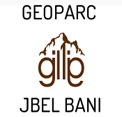
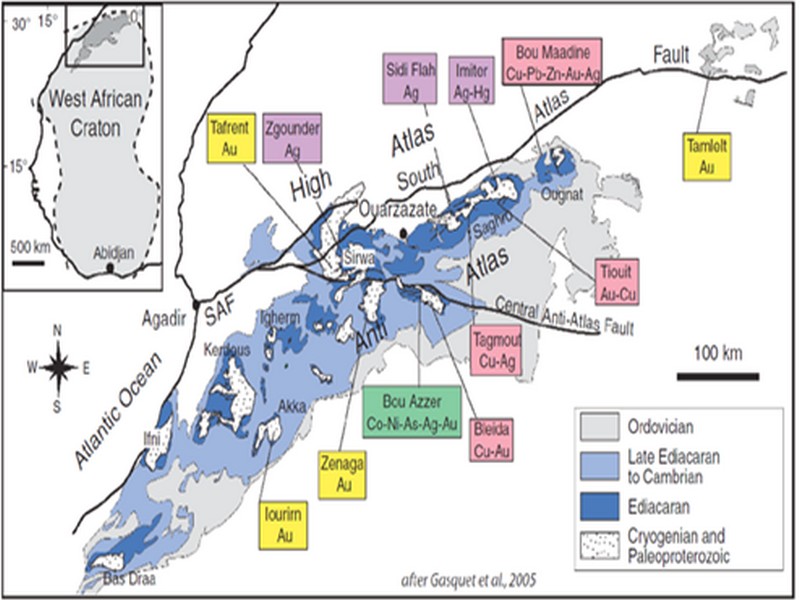
ORE DEPOSITS IN THE ANTI-ATLAS AND SUB-ATLAS REGIONS
The Anti-Atlas geological province is the host of a variety of ore deposits, ranging from Paléoprotérozoïque to Ordovician in age. These deposits are mainly Cu-Au porphyry types, precious metal epithermal (Au, Ag) or polymetallic VMS base metals (Cu, Pb, Zn, Au, and Ag), while the sub- Atlas region presents an important occurrence of manganese. Figure 8 shows the location of the most important deposits in the Anti-Atlas region.
Located in eastern Anti-Atlas, the world class Imiter Ag-Hg mine (8.5 Mt at 700g/t Ag), is among the most important deposits in Morocco. It is considered to be of epithermal origin. The silver mineralisation happened during regional extension (+/- transpession?) tectonic regime event around 550 and is hosted in a series of volcanic felsic rocks Ma (Tuduri et al, 2006). Briefly, a three-stage model has been proposed to explain the deposit: a first episode characterized by the development of quartz, pink dolomite, and Ag-rich minerals veins formed during a dextral transpressive event, followed by a barren stage associated with a normal left-lateral motion that re-opened previous structures, and a final alteration stage (i.e. supergene enrichment) that contributed to local enrichment in Ag deposit (Tuduri et al, 2006).
Regarding copper, Bleida was the most important Cu deposit of northern Africa until late 90’s. Located on the northern edge of the West African Craton, the Bleida orebodies are located on an inactive continental margin along with preserved ophiolites of Upper Proterozoic age. The copper deposits (chalcopyrite, bornite, pyrite) are stratiform distal massive sulfide bodies whose position is controlled by both the sedimentation of shales and an acid volcanism, which follows a more important basic volcanism. Pan-African deformation (650-600 Ma) has determined the current geometry of the cupriferous lenses although it has not remobilized the sulfides out of their original carrier beds (Leblanc and Billaud, 2006). West of the main Moroccan Bleida copper deposit, gold mineralization has also been discovered (West Bleida, ca. 3 tonnes metal Au). It is hosted by metamorphosed and deformed mafic to intermediate volcanic rocks that are part of the Neoproterozoic tholeiitic volcano-sedimentary series forming the stratigraphically upper part of the Bou Azzer ophiolite sequence. Gold mineralization primarily occurs
as deformed gold-bearing quartz veins and disseminations in Cu-rich chert zones (chalcopyrite– malachite), Fe-rich lithofacies and breccia zones. Gold is accompanied by small amounts of copper sulphides (<1% modal chalcopyrite).
Another important occurrence (not displayed in the map, Fig. 8) is the Imini Manganese deposit, the most important Mn deposit of Morocco, located in the western margin of the Ouarzazate foreland basin (Sub-Atlas). The manganese ore is made of pyrolusite (MnO2), and is hosted in different horizons of dolomites from the lower Cretaceous, and another accessory layer. This layers thickness can reach up to 1 meter. The deposit scale is 25 km per 100-400 m width, and sits above slates and crystalline rocks. Dolomitic sandstone and/or conglomerate are present between each mineralized horizon. Isabel von Steinaecker; source: http://www.geo.tu-freiberg.de/oberseminar/os03_04/Isabel_Steinaecker.pdf).
Figure 8: The Anti-Atlas belt at the northern limit of the West African Craton. Redrawn after Dallmeyer and Lecorché (1991) and a geological sketch map of the Anti-Atlas belt in southern Morocco and location of main ore deposits. SAF: South Atlas Fault. Gasquet and al. (2005)
Source web par unige.ch
Les articles en relation
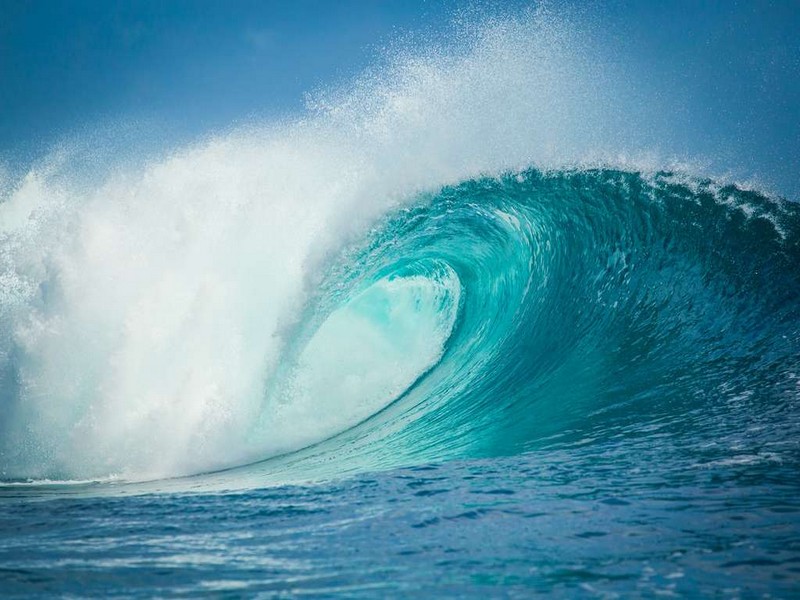
Vague
Vague Du point de vue du physicien, une vague correspond à une onde mécanique qui se propage à l'interface entre la surface de l'eau et l'air. Celle-ci se caractérise par sa longueur d'onde
Savoir plus...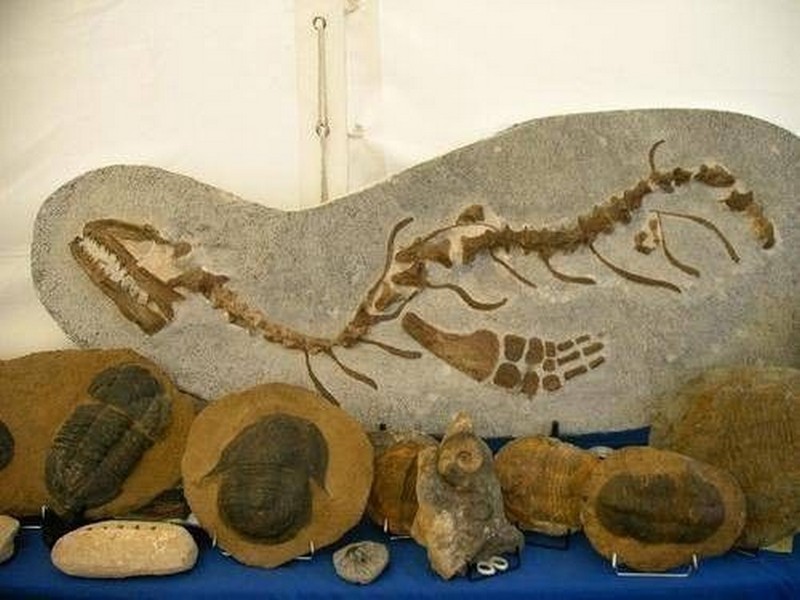
Les fossiles de l’Anti-Atlas (Géoparc Jbel Bani)
Les fossiles de l’Anti-Atlas (Géoparc Jbel Bani) Si le Maroc nous propose des paysages variés, les activités peuvent être tout autant diverses. Trekking, randonnées pédestres, spor
Savoir plus...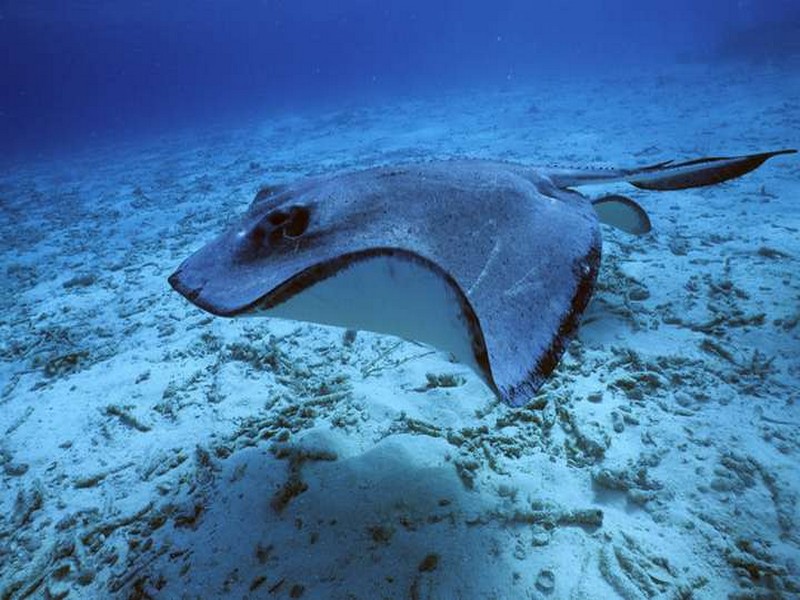
Raie pastenague
Raie pastenague La raie pastenague désigne plusieurs espèces de sélaciens de la famille des Dasyatidés, reconnaissables à une queue en forme de fouet, ce qui leur vaut ce nom. Mangeuses de petits po
Savoir plus...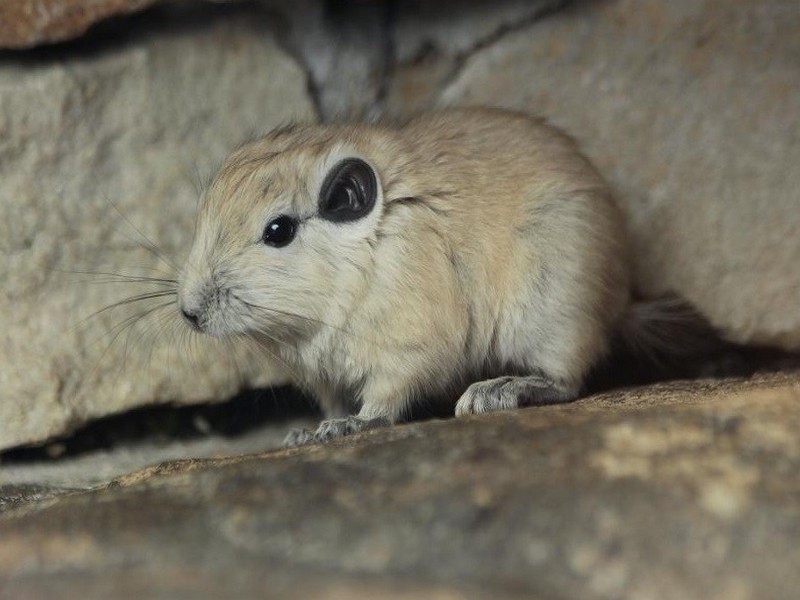
Le Goundi
Le Goundi est une espèce de petits rongeurs de la famille des Ctenodactylidae. C’est un rongeur et mammifère diurne qui habite les régions semi-désertiques de l’Afrique du Nord. Au Maroc on en
Savoir plus...
Vallée de Tamanart 60 sites d’art rupestre parsèment la zone
Dans le cadre de ses activités, l’Association marocaine d’art rupestre (AMAR) créée en 1999 a organisé du 1 au 4 mai une excursion scientifique à la vallée de Tamanart. Le choix du lieu
Savoir plus...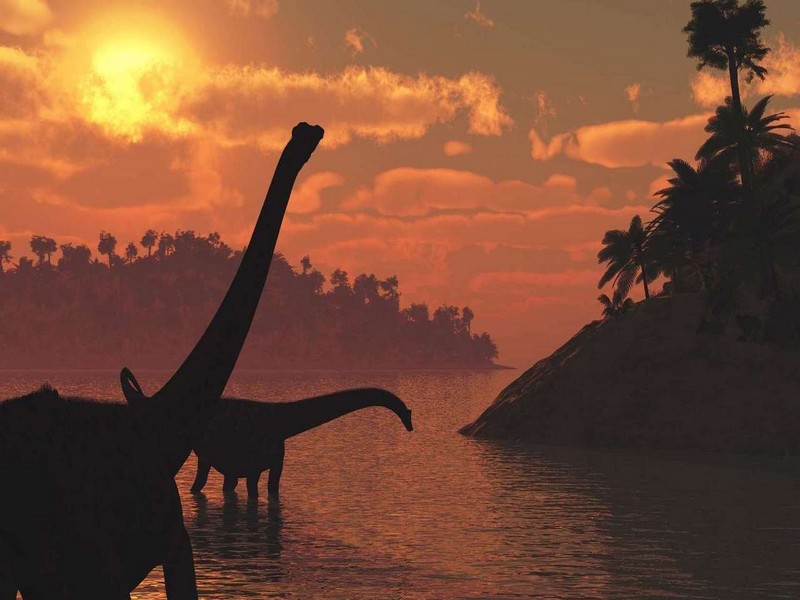
Disparition des dinosaures : l'astéroïde aurait plongé la Terre dans la nuit durant 2 ans
Disparition des dinosaures : l'astéroïde aurait plongé la Terre dans la nuit durant 2 ans Une nouvelle simulation de l'impact des incendies producteurs de suies causés par l'impact d'un ast&e
Savoir plus...
Le travail du cuir : À l'origine du
Le travail du cuir : À l'origine du "maroquin"... Le cuir marocain est réputé depuis des siècles à travers le monde. C'est d'ailleurs au XIVe siècle que l'on commen
Savoir plus...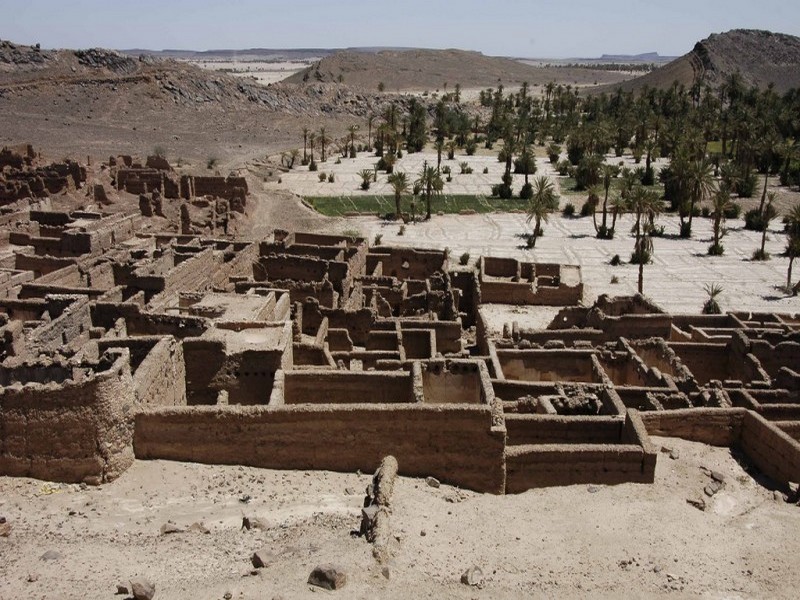
Oasis et anti atlas –tata
Tata est une oasis du sud marocain, elle se situe à proximité de la frontière Algérienne sur les contreforts de l’Anti-Atlas. La petite ville de Tata se trouve à 289 km au sud de la ville d&rsqu
Savoir plus...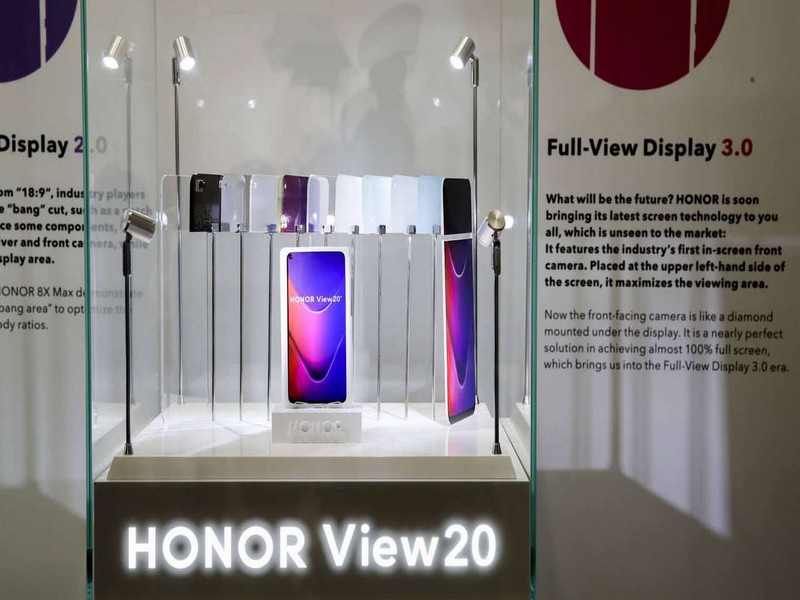
Honor View 20, un smartphone avec un trou dans l'écran
Honor View 20, un smartphone avec un trou dans l'écran Trois innovations dans le nouveau smartphone haut de gamme Honor : un capteur caché directement dans l’écran, un capteur de 48 millions de pixels e
Savoir plus...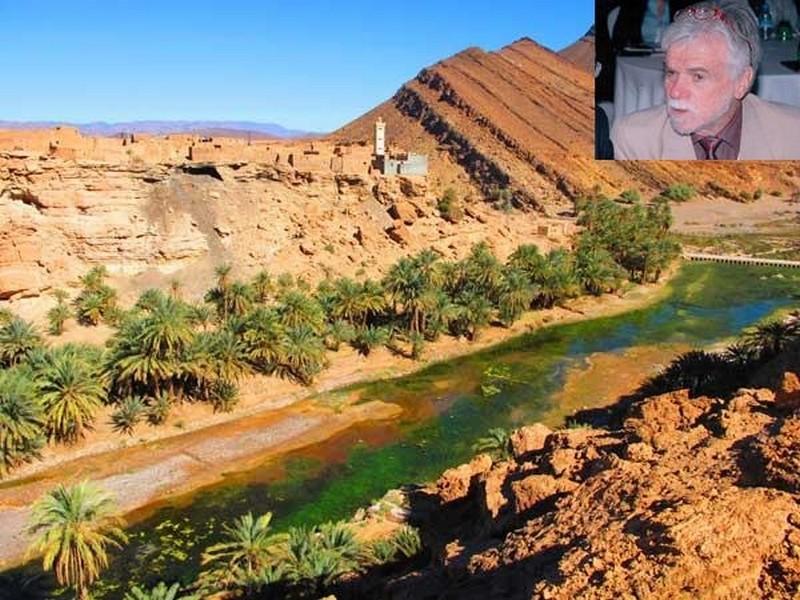
Naissance d’une association pour le développement du Géoparc de Jbel Bani à Tata
Naissance d’une association pour le développement du Géoparc de Jbel Bani à Tata La ville de Tata a abrité, le 10 avril courant, la 8ème édition de sa foire agricole. C’est l&r
Savoir plus...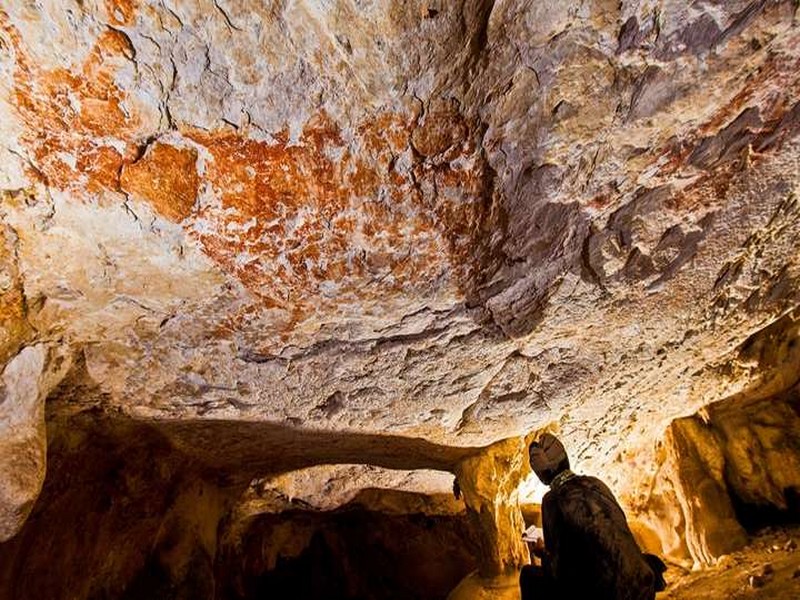
Les plus anciennes peintures figuratives du monde ont plus de 40.000 ans
Les plus anciennes peintures figuratives du monde ont plus de 40.000 ans Depuis les années 1990, les chercheurs savent qu'il se cache, dans les montagnes reculées et accidentées de Bornéo, des grottes
Savoir plus...Les tags en relation
En savoir plus sur " Géologie et TSGJB - AMDGJB ! "
Consulter les vidéos de " Géologie et TSGJB - AMDGJB ! " Consulter les photos de " Géologie et TSGJB - AMDGJB ! " Consulter les publications de " Géologie et TSGJB - AMDGJB ! " Consulter les éditions de " Géologie et TSGJB - AMDGJB ! " Consulter les communications de " Géologie et TSGJB - AMDGJB ! "Recherche du site
Recherche avancée / SpécifiqueVulgarisation à la géologie
Qu'est ce que les sciences de la terre: vulgarisation Qu'est ce que la géologie ? Géologie et TSGJB - AMDGJB !
Géoparc et Recherche Scientifique
Le coins de l’étudiant
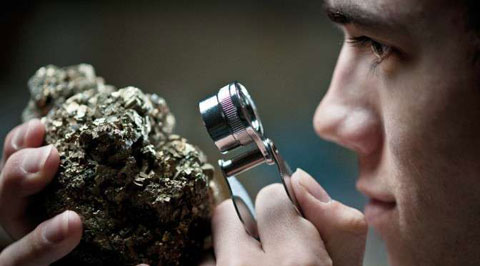


Blog Géoparc Jbel Bani
Dictionnaire scientifique
Plus de 123.000 mots scientifiques
Les publications
Géo parc Jbel Bani

Circuits & excursions touristiques

cartothéques


Photothéques
Publications & éditions



